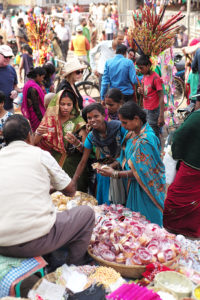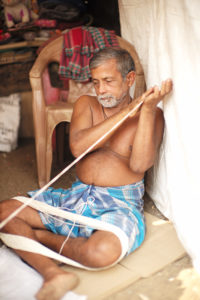By William G. Barnard, IV; [email protected]; He lives with his wife Sujata Lakhe and step-daughter Samira in Chagrin Falls and has visited India seven times. His interests include Computer Sciences, Leica photography, wood-working, Arts, traveling and volunteering. His photographs have appeared in the Cleveland Museum of Arts rack card and had honorable mention in the Washington Post travel contest. He also creates art from pressed Botanical specimens.
Whenever Sujata and I travel to India we try to stop at one of the 35 World Heritage sites that can be found within the country. The attention that the UNESCO designation gives these sites makes for a trip that will have an interesting landmark and have the tourism infrastructure that allows for adequate lodgings and transportation. This is especially nice for me with my limited Hindi skills. It allows me to hail an auto in Agra and just say “Taj Mahal” and I know the driver will get me there.

This year we traveled to Odisha to see the Sun Temple in Konark. This 13th century temple was built to represent the “chariot” that the sun god, Surya, rides across the sky every day. The chariot is defined by the seven stone horses that pull the temple on its 24 carved wagon wheels that the temple appears to ride on. Although the main sanctum of the temple and the surrounding structures have fallen the remaining Audience Hall (Jagamohana) is an impressive structure that seems to tower over the market leading up to the temple entrance. The real sights to see are not the imposing structures but the detailed and extensive carvings covering the temple. Many of the carvings show important scenes from life around the temple. Wedding processions, deities and signs of trade with foreign lands can be found covering the temple.
One of my favorite things to do in India is visiting the smaller temples that you find along the way during your trip. The more interesting ones usually have been in existence for many years and are located at a geographical landmark. Some times they have an oddity that makes the visit to the temple extra special. They are not the most interesting architecturally, but they and their surroundings tend to have a character that is difficult to ignore.
Not far from Konark we found the Ramachandi Goddess Temple that over looks an estuary at the mouth of the Kushabhadra river. This small temple with its lively market gives visitors an impressive experience of Indian life. Within the temple lamps can be lit before entering the sanctum of the temple. The lamps along with flowers and other votive items can be purchased inside the temple. The Ramachandi Temple has a very interesting feature. It has a partial skeleton of a whale shark that was found in the Bay of Bengal near the temple in 1994. The six foot tall skull of the shark was draped in garlands and treated almost as if it were a deity itself.
The market outside of the temple seemed low pressure compared to the stands we encountered outside of the Sun Temple in Konark. The owners would wait until you showed interest in an item for sale and the seller would engage with us. In the market we found a merchant tying bracelets he would sell for use as sacred threads to be blessed in the temple.
Not far from Konark is Puri where the famous Jagannath Temple is located. Despite the warning that non-Hindus were not permitted inside the temple by our travel guide book we proceeded to Puri. Sujata told me that she was not going to miss a chance to enter the temple when she was so close to it. I decided to make the best of the situation and bring my camera to the entrance of the temple so I could catch some of the life that was happening outside of the temple.
When we arrived in Puri we traveled down Grand Rd. a wide avenue that leads to the temple is lined by shops and restaurants. Cars and buses are not permitted within 1km of the temple so our driver parked on the street and we hired a rickshaw to the temple. At the entrance of the temple, the market that marks the end of Grand Rd. was vibrant with pilgrims, shops and rickshaws. The day that we visited on was just a typical Wednesday with no religious significance but the number of people were more than I have ever seen in front of other temples or cathedrals that I’ve visited before. This was a really popular place to be at. I wondered what it would be like when a festival that would draw more pilgrims to fill the square up. The Jagannath Temple is famous for the Rata Yatra festival which lasts for a few days. The procession in which the Gods are taken out of their shrine to visit another temple.
The priest or Pandaas, as they are called, are omnipresent. But they were silently and quietly present and not very pushy. Sujata made a contract with a traditionally, but stylishly dressed younger Pandaa. He said it would be impossible for me to enter the temple as I was not Hindu. The Pandaa also said Sujata should not mention her Marathi heritage to the priests inside the temple. Evidently the Odiya priests in the temple remember when the Maratha Empire ruled over this part of Odisha in the 17th century. Sujata told me she would meet me at a textile shop in the square in an hour and then she headed into the temple. With that I was left to explore the market on my own.

I hoped to get some good photographs of the devotees as they entered or left the temple, so I positioned myself at the exit of the temple waiting for an interesting scene to unfold. It didn’t last long for me to be chased out from the front of the temple by beggars looking for donations. I then decide to move to the shops that stood across the square from the temple. One shop that sold metal items including plates and cups had craftsmen out front inscribing items with just a hammer and punch. Many of the other stands in the market were selling bangles and devotional items for the pilgrims to buy for blessing in the temple or donating to the deities.
I worked my way the Textile shop that I was to meet Sujata at and found that the store front was elevated above the street. The area in from of the shop hosted popup vendors with their wares in baskets. This area had what seemed to be an army of barbers armed with only straight razors. There were several men getting their heads shaved when I arrived. They were being shaved before entering the temple. Some were saving the hair but most were leaving it to lay on the ground to be swept up later. One family with a little girl who was not interested in having her head shaved was crying and thrashing around violently while a very patient berber with his razor waited for the girl’s parents to hold her still.
When Sujata returned from he temple she told me of all the things she saw in there. She said that the puja and blessing included being struck on the head with two sticks by a priest. The sticks would make an audible crack when they connected with the head. So I didn’t feel too bad about not getting to go inside.

